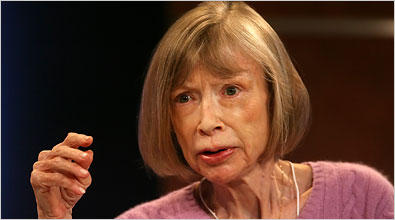Didion, Joan. Blue Nights, Alfred A. Knopf, New York, 2011 (188pp.$25)
One of our finest, quintessentially American writers, Joan Didion, is the author of fiver novels and eight works of nonfiction. The nonfiction has been collected as “We Tell Ourselves Stories in Order to Live” by the stalwart Everyman’s Library. For many years, she and her husband, John Gregory Dunne, lived and worked in California, always on the edge of the movie business, each busy with projects, deadlines, parties and friends. The hallmark of Didion’s nonfiction was its scrupulous devotion to truth-seeking and a looping, scarifying style. Like Mailer, she was muscular, enigmatic, mercurial and cultured.
In 1966, she and her husband adopted a baby at birth, named her Quintana Roo after the Mexican province, and proceeded to raise their only child in an atmosphere of fevered literary achievement and privilege. And then, in December 2005, Didion’s famous husband John collapsed and died of a massive heard attack at the dinner table. Didion, shattered, wrote her famous memoir, “The Year of Magical Thinking”, to counter the shock. That same week, 39-year old Quintana came down with flu-like symptoms, then pneumonia, and slipped into a coma. Didion held off the funeral of her husband for three months while Quintana’s life hung in the balance. Quintana survived, barely.
Then in August of 2005, Quintana developed a full-body infection, recovered briefly, then suffered a pulmonary embolism with arterial bleeding, felt better briefly, then collapsed with a massive hematoma. Brain surgery followed and death followed brain surgery. “Blue Nights” is Didion’s effort to come to terms.
The book’s title refers to twilight, which is long in New York, short in California. This observation in and of itself may or may not be true, but certainly foretells the author’s increasingly decreased power. The blue night symbolizes also the fading memory and the writer’s increasing inability to focus on “anything save illness, the end of promise, the fading of the day, the warnings of death and incapacity.” “Blue Nights as a book may well be the end of Didion’s promise as a writer.
Didion reports that after the baby’s adoption ceremony she and her husband “took her from the courthouse in downtown Los Angeles to lunch at the Bistro in Beverly Hills.” Did they really take the baby to lunch, or did they go to lunch and show off the baby in a fancy California restaurant? Thereafter “Blue Nights” is littered with brand names, allusions to high-fashion designer apparel, fancy friends (Natalie Wood, Paul Newman), suites at the Ritz, the Plaza Athenee in Paris, and even a flowered Porthault parasol to shade the baby. But in the background, always in the background, was Quintana Roo and her illnesses, her “quicksilver changes” her depths and shallows, and her Broken Man who was out there in the dark. Of course these things were assigned names by doctors: “The names kept changing, manic depression became OCD and OCD was short for obsessive-compulsive disorder and obsessive compulsive disorder became something else, I could never remember just what but in any case it made no difference because by the time I did remember there would be a new name, a new diagnosis.” “Blue Nights” may well spell the end of Didion’s ability to remember.
Didion reports that the week after placing Quintana Roo’s ashes in the wall of S. John the Divine in New York, she flew to Boston and back to New York and then to Dallas and back to New York and then to Minneapolis and back to New York, doing promotion for “The Year of Magical Thinking”, under the “misapprehension” that momentum was about traveling. Not long after that, her one-character play starring Vanessa Redgrave opened on Broadway (Didion reminds us that it played 144 performances.) Fortunately, Didion can remember all this.
Frankly, “Blue Nights” is not really about Quintana Roo, not really about the suffering and death of a child, nor even about suffering in general. After a life of telling the truth, after a career of facing up to the harsh realities of things like politics and war and social status, Didion finds herself stranded with the fading, almost opaque memories of long gone champagne lunches, expensive designer dresses, evenings “on the set”, and the hazily related recollections of a troubled little girl. None of it amounts to art or literature and that’s because neither art nor literature can do anything about either Quintana or John.


